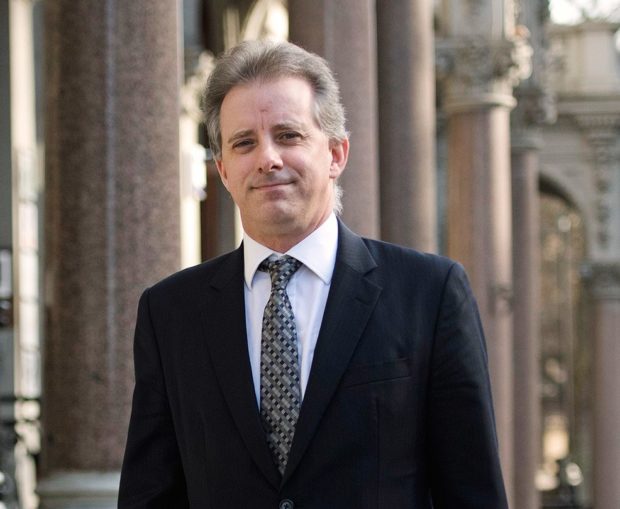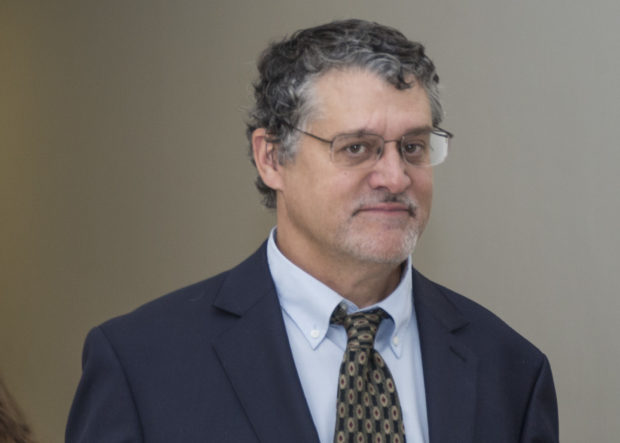- An FBI memo declassified this month led to the revelation that Igor Danchenko was the primary source of information for dossier author Christopher Steele.
- Danchenko’s statements to the FBI have called into question some of the longstanding media narratives about the sourcing for Steele’s dossier.
- In particular is the role, if any, that a Belarusian-American businessman named Sergei Millian played as a source for Danchenko and Steele.
- Steele told the FBI he believed that Millian was the source of several explosive allegations in the dossier. But Danchenko told the FBI that he believes he may have talked to Millian just once in a brief phone call.
The release of an FBI memo this month shed new light on the sources of information for the Steele dossier, while raising questions about what role if any a Belarusian-American businessman referred to as “Source 6” played in the matter.
Sergei Millian was identified in news reports published on Jan. 24, 2017 as an unwitting but significant source for the dossier’s most explosive allegations regarding Donald Trump and his campaign.
On the same day those stories were published, a Russia analyst who was Christopher Steele’s primary source provided the FBI with information that undercut several aspects of the dossier, including that Millian was a major source for the document.
Igor Danchenko, the analyst, told the FBI in interviews from Jan. 24-26, 2017 that he worked for Steele’s firm Orbis Business Intelligence to collect information about any links between the Trump campaign and Russia.
While Steele told the FBI that Millian was a sub-source for Danchenko, Danchenko told investigators he was not entirely certain that he ever spoke to Millian. According to the newly declassified FBI memo, Danchenko said that he believed he spoke to Millian in one 10-15 minute phone conversation in late July 2016, but that the man on the other end of the phone did not identify himself.
If Danchenko did speak to Millian, the conversation occurred more than one month after Steele wrote the dossier’s most incendiary allegation, which media reports attributed to Millian.
The analysis of Millian’s involvement (or non-involvement) in the dossier hinges on whether Danchenko was forthcoming with the FBI. There is no indication that he made false statements during the interview, though an FBI supervisory intelligence analyst who took part in the interview told the Justice Department’s inspector general that he wondered if Danchenko was “minimizing” his contacts with Millian.
Steele, a former MI6 officer, wrote 17 memos based on information he claimed came from Danchenko that alleged a massive conspiracy between the Trump campaign and Kremlin. Steele also alleged that the Kremlin had video of Trump with a group of prostitutes in Moscow in 2013.
Steele provided parts of his dossier to the FBI. The entire document eventually made its way into the hands of a reporter at BuzzFeed News, who published the document on Jan. 10, 2017.
Two weeks later, The Wall Street Journal and ABC News reported that Millian was an unwitting source for some of the most explosive claims in the dossier, including the Trump sex romp story.
Numerous news outlets, including the Daily Caller News Foundation, have published stories about Millian based on his purported role as a source for the dossier.

Christopher Steele in London (VICTORIA JONES/GETTY IMAGES)
Millian and his defenders have asserted that Steele and and his partners at Fusion GPS have fingered him as a key source in order to distract from numerous problems with the dossier. The Justice Department inspector general (IG) all but debunked Steele’s core allegation of a conspiracy between the Trump campaign and Russia in 2016.
A report from the IG said that Danchenko’s statements to the FBI “raised significant questions about the reliability of the Steele reporting.”
Danchenko, who was an analyst at the Brookings Institution prior to working for Steele, provided the FBI with details of six sub-sources who he claims formed the basis for most of the allegations in the dossier, according to the declassified FBI memo.
Millian, the former chairman of the Russian-American Chamber of Commerce, is “Source 6” in the memo.
During the 2016 campaign, Millian surfaced in several news stories because of purported links to associates of Donald Trump. It was later revealed that Millian and Trump campaign adviser George Papadopoulos met during the heat of the campaign.
Millian reached out to Papadopoulos in mid-July 2016, and the pair met for the first time later that month. The special counsel’s report says that Millian offered in an Aug. 23, 2016 message to Papadopoulos to “share with you a disruptive technology that might be instrumental in your political work for the campaign.”
Initial media reports about Millian as a possible dossier source contained a bizarre claim that Millian was referred to in different memos as “Source D,” “Source E,” a “Russian émigré figure” close to Trump, and an “ethnic Russian associate” of Trump.
As Source D, Millian was purported to have claimed he was present when Trump supposedly used prostitutes in Moscow. As Source E, he was said to have confided that the Trump campaign was engaged in a “well-developed conspiracy of cooperation” with the Kremlin.
The other memos asserted that Millian claimed that the Kremlin had fed Trump information for eight years, and that it was Carter Page’s idea to leak Democrats’ hacked emails through WikiLeaks.
The special counsel’s report said investigators found no evidence to support any of those allegations.
Danchenko identified one of his other five sources — a woman he had known since high school — as being key to the dossier, according to the FBI memo. (RELATED: A Russia Analyst Living In The US Has Been Identified As The Key Steele Dossier Source)
Danchenko said that the woman, “Source 3,” provided him information about Carter Page and Michael Cohen. The IG report said that the FBI received information on Jan. 12, 2017 that the dossier’s claim about Cohen may have been the product of Russian disinformation.
The report also said that the FBI received evidence that the Trump sex tape claim may have been Russian disinformation, and that at least two Russian intelligence officers were aware by July 2016 that Steele was investigating Trump.
Even if Millian was the person who phoned Danchenko, Danchenko said that his interlocutor did not provide any damning information regarding Trump or his associates.
Danchenko recalled “nothing bad” from the phone call he believed was with Millian regarding the Trump campaign and the Kremlin and no mention of WikiLeaks, according to the FBI memo of his interviews.
Danchenko told the FBI he was urged to contact Millian after asking a journalist friend for tips on anyone who might have information about Donald Trump. He said he sent two emails to Millian with no response and that he received a “bizarre” phone call in late July 2016 that he believed was from Millian.

Fusion GPS Co-Founder Glenn Simpson (Zach Gibson/Getty Images)
Millian published emails over the weekend that Danchenko sent him in July and August 2016 which suggest that the reporter was Dmitri Zlodorev of RIA Novosti, state-owned media outlet.
Millian did an interview with Zlodorev in April 2016 in which he suggested that he knew Trump and had been in contact with members of his campaign days earlier. Millian also said that he believed that Trump would relax sanctions against Russia in order to repair the country’s relations with the United States.
According to Millian, Danchenko emailed him on July 21, 2016 and Aug. 18, 2016.
“Colleagues from RIA Novosti gave me your contact. You spoke with Dmitry Zlodarev about Donald Trump and his travels to Russia,” Danchenko wrote in the first email, according to Millian.
????PSS emails release THREAD: —— My name is Sergei Millian. As a member of GOP & active supporter of Mr. Trump I got viciously targeted by the anti-Trump elements, foreign & domestic.
— MILLIAN (@SergeiMillian) July 25, 2020
That timeline would seem to undercut the theory that Millian was a source for the Trump sex story, given that Steele wrote his memo on that topic on June 20, 2016, more than a month after Danchenko first reached out to Millian.
The discrepancy between Danchenko’s FBI statements and Steele’s dossier reporting has not been explained. If Steele obtained information from Millian through another source, he has yet to discuss it publicly.
Zlodorev, the RIA Novosti reporter, did not respond to several requests for comment. A lawyer for Danchenko did not respond to a request for comment, nor did Steele’s firm.
One mystery that arises from the Danchenko revelations is why Millian would have been the alleged source exposed in the media in January 2017 rather than Danchenko or one of his other sub-sources.
But a timeline of events starting in July 2016 shows that Fusion GPS, the firm that hired Steele on behalf of the Clinton campaign, was pushing Millian’s name to media outlets as a possible intermediary between the Trump campaign and Russia.
Glenn Simpson, the founder of Fusion GPS, wrote in a book published in November that Nellie Ohr, a Fusion contractor, began researching Millian in late 2015. Simpson said that as Ohr was researching Millian, his name was mentioned to them by Steele.
According to journalists Michael Isikoff and David Corn in their book, “Russian Roulette,” Simpson urged then-ABC News journalist Brian Ross to contact Millian for an interview.
On July 29, 2016, Ross plied Millian with pointed questions about Trump’s activities in Russia. The veteran journalist also asked Millian if he was a Russian spy. Millian made some cryptic remarks in the interview, such as that Trump had “tricks up his sleeve” to win the election. He said that he had contacts at the Kremlin, but denied being a Russian intelligence officer.
Ross was the lead reporter on the Jan. 24, 2017 story that identified Millian as the key dossier source.
Millian’s name popped up in other stories published at Fusion-friendly news outlets.
The Daily Beast wrote about Millian in Sept. 2016. The Financial Times published a story on Oct. 31, 2016 referring to Millian as a “shadowy Russian emigre” linked to Trump.
On Jan. 19, 2017, David Corn published a story in Mother Jones suggesting that investigators speak with Millian. Corn and Michael Isikoff of Yahoo! News met with Steele and Simpson prior to the 2016 election, and published stories that used Steele as a source.
While Fusion GPS was busy circulating Millian’s name to reporters, Steele was feeding it to the FBI and other government agencies.
According to the IG report, Steele told FBI agents during a meeting on Oct. 3, 2016 that Millian was a subsource for the dossier. Steele told investigators he believed Millian was a “boaster” and “egotist” who “may engage in some embellishment.”
The IG report faulted the FBI for failing to disclose Steele’s remarks about Millian and Danchenko’s statements in its applications to surveil Page.
The FBI opened a counterintelligence investigation into Millian at some point after the interview with Steele in early October 2016. It is not entirely clear if Steele’s statements were the catalyst for opening the probe.
Steele also mentioned Millian in an Oct. 11, 2016 meeting with State Department official Kathleen Kavalec, according to notes that she took at the time.
Steele discussed Millian with Bruce Ohr, a Justice Department official whose wife, Nellie Ohr, was a Fusion GPS contractor. Steele met with the Ohrs during a trip to Washington, D.C. on July 30, 2016. According to Nellie Ohr, Steele was accompanied by a man whose name she did not recall. It is unclear if Steele was with Danchenko, who lives outside of Washington, D.C.
In the days before Danchenko met with the FBI, Steele and Glenn Simpson expressed concern to Ohr about the safety of the dossier source.
According to Ohr’s notes, Simpson told him on Jan. 20, 2017 that Steele had been unable to get in touch with the source.
“They can’t reach him, Glen [sic] doesn’t know name,” Ohr wrote, according to his notes.
Steele called Ohr the following day, expressing concern for the safety of the source, saying that he “may need help quickly.”
Steele sent Ohr text messages expressing concern that he had not heard from his source.
“They will reach out to him tomorrow to see where he is,” Ohr wrote in notes from Jan. 25, 2017.
Danchenko told the FBI that Steele reached out to him that same day. He said he planned to respond to Steele later in the day and tell him that he had been meeting with someone whose identity is redacted in the FBI memo.
It is unclear whether Danchenko ever told Steele he met with the FBI.
The FBI used the publication of the dossier to advance several aspects of Crossfire Hurricane even after red flags emerged calling Steele’s reliability into question. FBI agents investigating Papadopoulos also used the Millian story as cover to interview the former Trump aide.
Peter Strzok, the deputy chief of counterintelligence, wrote to FBI attorney Lisa Page on the day that BuzzFeed published the dossier that he wanted to use the event as an opportunity to interview witnesses in the Russia probe.
“We’re discussing whether, now that this is out, we use it as a pretext to go interview some people,” Strzok wrote.
The New York Times reported Saturday that the FBI identified Danchenko as the Steele dossier source on Jan. 13, 2017. David Laufman, a Justice Department official at the time, arranged an interview with Danchenko’s lawyer. The Russian national agreed to the interview in exchange for immunity.
FBI agents also used Millian’s prominence in press reports to approach George Papadopoulos, a former Trump campaign aide, for an interview on Jan. 27, 2017.
Court filings in Papadopoulos’s criminal case said that agents asked him to talk about Millian and his purported role as a dossier source ahead of an interview on Jan. 27, 2017.
All content created by the Daily Caller News Foundation, an independent and nonpartisan newswire service, is available without charge to any legitimate news publisher that can provide a large audience. All republished articles must include our logo, our reporter’s byline and their DCNF affiliation. For any questions about our guidelines or partnering with us, please contact licensing@dailycallernewsfoundation.org.


